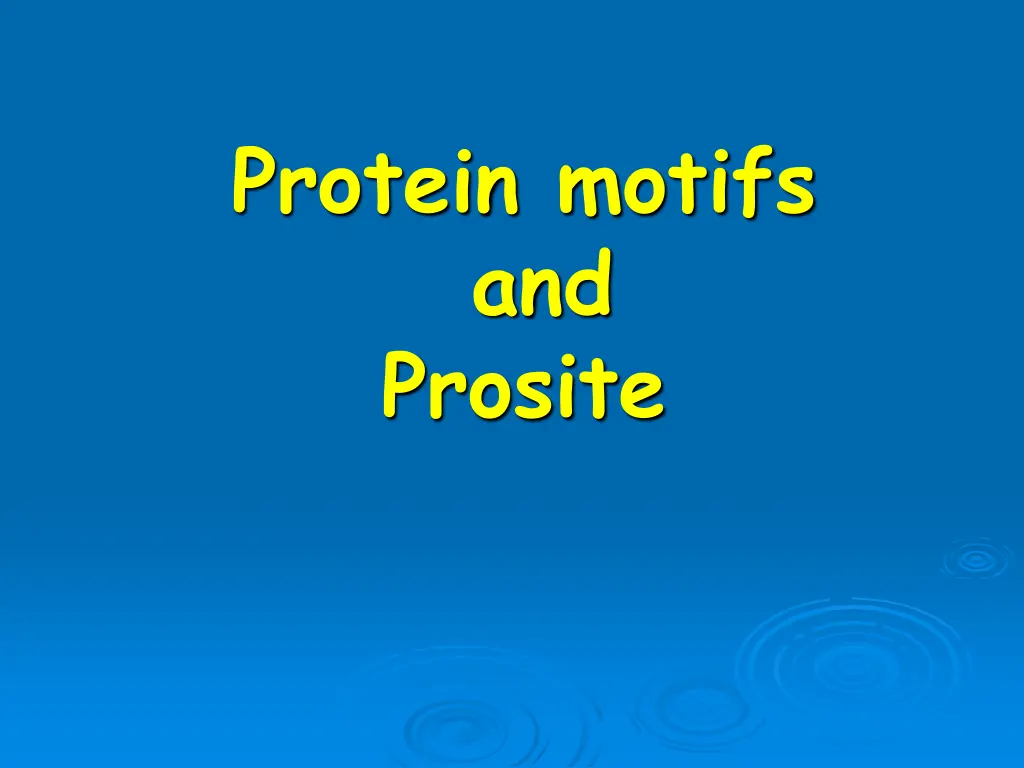
Understanding Protein Motifs and Patterns
Explore the world of protein motifs, turning raw data into biological knowledge, and the significance of sequence motifs in protein function. Discover how to identify and decode patterns in protein sequences to gain insights into their biological roles.
Download Presentation

Please find below an Image/Link to download the presentation.
The content on the website is provided AS IS for your information and personal use only. It may not be sold, licensed, or shared on other websites without obtaining consent from the author. If you encounter any issues during the download, it is possible that the publisher has removed the file from their server.
You are allowed to download the files provided on this website for personal or commercial use, subject to the condition that they are used lawfully. All files are the property of their respective owners.
The content on the website is provided AS IS for your information and personal use only. It may not be sold, licensed, or shared on other websites without obtaining consent from the author.
E N D
Presentation Transcript
Protein motifs and Prosite
Turning information into knowledge The outcome of a sequencing project is masses of raw data The challenge is to turn this raw data into biological knowledge A valuable tool for this challenge is an automated diagnostic pipe through which newly determined sequences can be streamlined
From sequence to function Nature tends to innovate rather than invent Proteins are composed of functional elements: domains and motifs Domains are structural units that carry out a certain function The same domains are shared between different proteins Motifs are shorter sequences with certain biological activity
What is a motif? A sequence motif = a certain sequence that is widespread and conjectured to have biological significance Examples: KDEL ER-lumen retention signal PKKKRKV an NLS (nuclear localization signal)
More loosely defined motifs KDEL (usually) + HDEL (rarely) = [HK]-D-E-L: H or K at the first position This is called a pattern (in Biology), or a regular expression (in computer science)
Syntax of a pattern Example: W-x(9,11)-[FYV]-[FYW]-x(6,7)-[GSTNE]
Patterns W-x(9,11)-[FYV]-[FYW]-x(6,7)-[GSTNE] Any amino-acid, between 9-11 times F or Y or V WOPLASDFGYVWPPPLAWS ROPLASDFGYVWPPPLAWS WOPLASDFGYVWPPPLSQQQ
Patterns - syntax The standard IUPAC one-letter codes. x : any amino acid. [] : residues allowed at the position. {} : residues forbidden at the position. () : repetition of a pattern element are indicated in parenthesis. X(n) or X(n,m) to indicate the number or range of repetition. - : separates each pattern element. : indicated a N-terminal restriction of the pattern. : indicated a C-terminal restriction of the pattern. . : the period ends the pattern.
Profile-pattern-consensus consensus A A C T T G N A N T N N multiple alignment pattern A A C A A A C G C T T T T C T G G C [AC]-A-[GC]-T-[TC]-[GC] profile 1 2 3 4 5 A T C G 0.66 0 0.33 0 1 0 0 0 0 0 0 1 0 0 . . . . 0.66 0.33
Prosite A method for determining the function of uncharacterized translated protein sequences Database of annotated protein families and functional sites as well as associated patterns and profiles to identify them
Prosite Entries are represented with patterns or profiles profile 1 2 3 4 5 A T C G 0.66 0 0.33 0 1 0 0 0 0 0 0 1 0 0 . . . . 0.66 0.33 pattern [AC]-A-[GC]-T-[TC]-[GC] Profiles are used in Prosite when the motif is relatively divergent and it is difficult to represent as a pattern
Scanning Prosite Query: pattern Query: sequence Result: all sequences which adhere to this pattern Result: all patterns found in sequence
WebLogo http://weblogo.berkeley.edu/logo.cgi
Patterns with a high probability of occurrence Entries describing commonly found post- translational modifications or compositionally biased regions. Found in the majority of known protein sequences High probability of occurrence






















